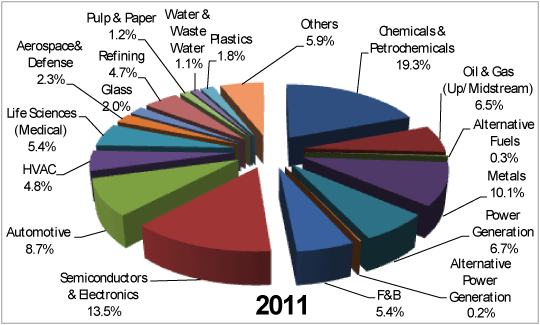The global temperature sensors and transmitters market is highly competitive, with a large number of participants. Temperature is one of the most frequently measured parameters, with temperature sensors used in many industries (if not all of them). Because temperature applications are so diverse—ranging from critical process control to maintaining comfort levels inside automobiles—there are several technologies that are used to measure temperature although temperature sensors can be broadly classified into two categories: contact and noncontact.
Contact sensors, as the name implies, must be in contact with the object whose temperature is being measured; it is assumed that the sensor and the object are in thermal equilibrium. Examples of contact temperature sensors include thermocouples, RTDs, thermistors, and IC sensors. Noncontact temperature sensors, such as infrared (IR) sensors, read a portion of the electromagnetic energy emitted by the object and then measure its intensity.
Some of the contact temperature sensor technologies have been present for decades and are considered mature and static. The noncontact temperature sensor technologies, in contrast, are more dynamic (still maturing) and are projected to show higher growth because of their increasing usage in a wide number of applications. Despite flat growth rates in certain technology segments, the overall temperature sensors and transmitters market is expected to grow during the 2011–2015 period because of stable economic conditions in many regions and robust growth in many emerging economies. Environmental legislation and demand from vertical market segments such as the automotive and telecommunications industries are expected to contribute to the growth of the temperature sensors and transmitters market as well.
End-User Trend Analysis
Considering revenue generation for the global temperature sensor market for 2011, temperature sensor and transmitter use in the chemical and petrochemical industry represents the largest contribution of 19.3% to the total revenues in 2011 (Figure 1). Oil and gas, metals, and automotive are the other key end markets that generate sizable revenues for the world temperature sensors and transmitters market. These industries use most of the different types of temperature sensor technologies.
 Figure 1. Revenue generation for the global temperature sensors market for 2011 |
Thermocouples are the temperature sensor of choice in many industries that require a stable sensor, featuring a fast response time, ease-of-use, low cost, and user familiarity. The chemical and petrochemical industries also use large numbers of RTDs because the sensors can operate in high-temperature and challenging industrial environments. IR sensors are used in several vertical markets, including extensive use in the plastic, metals, and food and beverage industries and they are making inroads into process applications.
The process industries are becoming the largest purchases of IR temperature sensors where they are used for spotting defects and measuring surface temperature. The use of IR temperature sensors in the process industries is estimated to generate a 29.3% revenue share in 2011, with further growth expected by 2015.
IR sensing in the food and beverage industry is used to detect immediate changes in temperature to lessen the risk of spoilage and reduce the chances of disease. Drivers for this market include government regulations, the need to minimize the amount of food wasted, and the need to reduce the number of batches rejected. The food and beverage industry's use of IR sensors is likely to contribute 5.4 % of the total temperature sensor revenue in 2011.
IC temperature sensors are used in a variety of industries in applications that require small, low-cost sensors that provide accurate temperature measurement. The revenue from the temperature sensor usage in computers and consumer electronics dominates the total revenues of the IC temperature sensor market. Trends in the personal computing industry such as smaller system size, faster processors, and the need to support more powerful applications make monitoring and controlling heat imperative and this, coupled with robust sales of desktop and portable computers, is likely to continue to support this market. In 2011, IC temperature sensor applications in the semiconductors and electronics industries amounted to 13.5 % of the revenue of the total temperature sensors market.
Thermistors are used in automotive, HVAC, medical, telecommunications, consumer electronics, and certain industrial applications. The process industries use fewer thermistors because of their narrow operating temperature range. The market for thermistors is expected to be driven by growth in the automotive market in the Asia Pacific region and in the emerging economies in Eastern Europe and Latin America, driven by an increased need for temperature measurement in vehicles for fuel efficiency and for passenger comfort. In the total temperature sensors market, thermistor use in automotive applications generates >8.7 % of the total revenue and thermistor use in HVAC applications generates 4.3% of the total revenue.
Noncontact temperature sensors, led by IR temperature sensors, are increasingly adopted for use in high-temperature applications. Several companies are investing in research and development to improve the existing noncontact IR temperature sensing technologies and to develop newer ones. A number of companies, including tier one automotive suppliers, have developed fixed IR temperature sensors to focus on markets that are currently dominated by thermocouples and RTDs. In the future, we predict strong competition between contact and noncontact temperature sensing technologies.
ABOUT THE AUTHOR
Dr. Rajender Thusu is the Industry Principal, Sensors Practice (Measurement and Instrumenatation) for Frost & Sullivan. He can be reached at 210-520-0941, [email protected].
